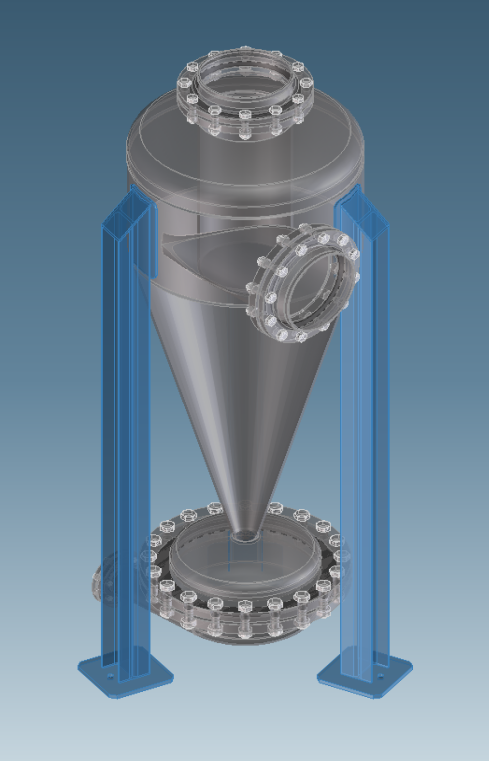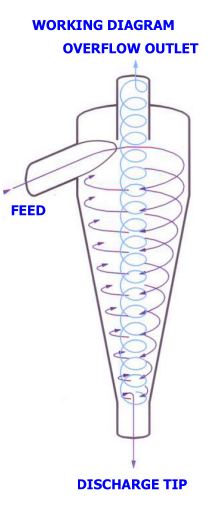
Cyclones
Industrial cyclones are static separators which, based on differences in density, separate the various components present in a two-phase fluid body.
Hydrocyclones
Unlike dry or powder cyclones, which separate solids or liquids from gases, hydrocyclones separate solids from fluids or fluids of different nature contained in the liquid body to be treated.
Components
A hydrocyclone includes a cylindrical-shaped feed part with tangential inlet; an overflow outlet with vortex generator; a conical part with a waste or separated discharge tip and possibly a collection part for the latter.

Working principle
The product is fed tangentially into the hydrocyclone at a pressure and speed given by the feeding system.
The introduction of the fluid phase creates a centrifugal movement pushing the heavier component outwards and downwards along the wall of the conical part.
The decreasing diameter in the conical part increases the speed and therefore improves the separation between the desired components.
Finally, the concentrated part with the highest density is discharged through the discharge tip.
The vortex maker in the outlet part generates a rapidly rotating upward spiral movement of the fluid in the center of the conical-shaped housing.
The fluid with a lower density is discharged, separated, through the overflow outlet.
Cyclone parameters
The following parameters are decisive for the good functioning of the cyclone:
– the design,
– the difference in specific weight between the two phases of the product to be separated,
– the shape of the product to be separated,
– the forward vecocity of the fluid,
– the density of the components of the two phases,
– the viscosity of the product to be treated,
– the supply pressure and the counterpressures necessary at the overflow outlet and at the discharge tip.
Application areas
The main areas of application for hydrocyclones are:
Industrial separation processes
Hydrocyclones are often used in industry for the separation of particles present in a fluid body.
Mineral processing industry
Hydrocyclones are frequently utilized in the metallurgical and mineral processing industry for the classification of fine particles and dewatering of slurries.
Sand separation and classification
Hydrocyclones used for sand separation and classification and as a separator of sand from water or sludge.
Oil-water separation
Separation of oil and water in, among other things, the offshore industry.
Dewatering
Concentration of slurry and dewater sludge for disposal.
Microplastic separation
Removal of microplastics from wastewater.
Main characteristic data of our hydrocyclones
Flow: from 1.22 to 37,000 gpm.
Inlet and outlet diameters: from 1/8″ to 40″.
Separation class depending on the fluids treated.
Versions
ISO, ANSI and JIS standars.
Closed or inspectable versions.
Materials: carbon steels, silicon steels, manganese steels, stainless steels, Monel, Hastelloy.
Accessories
Calibrated diaphragms for fine adjustment of flow rates.
Shut-off valves: inlet, outlet and by-pass.
Discharge: continuous or timed with accumulation tank.
Accumulation tank washing system.
For any information and configuration regarding cyclones and hydrocyclones capable to satisfying your specific needs, please contact our technical department.
